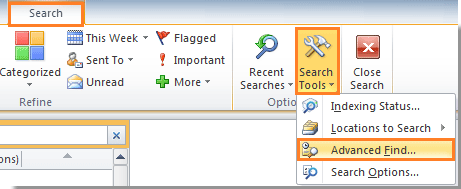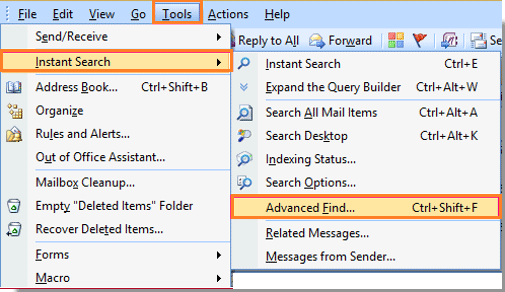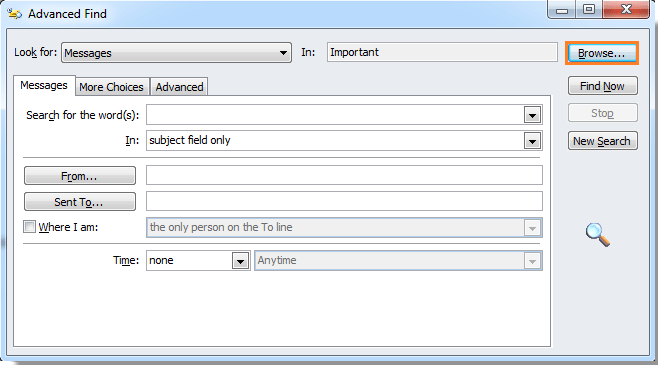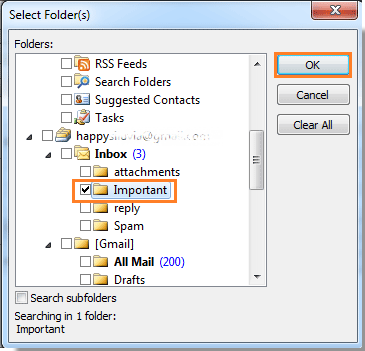Hur visar jag fullständig mappsökväg för e-postresultat i Outlook?
Har du känt dig frustrerad över att Outlook bara visar den innehållande mappen för varje matchande sökresultat? Om det finns mappar med samma namn i din Outlook är det tidskrävande att hitta den specifika mappen en efter en för ett visst sökresultat. Att visa fullständig mappsökväg för e-postsökresultat är ett effektivt sätt för dig att hitta den specifika mappen för de sökta e-postmeddelandena. Vänligen bläddra i följande artikel för mer detaljerad information.
Visa fullständig mappsökväg för e-postresultat i Outlook
 Visa fullständig mappsökväg för e-postresultat i Outlook
Visa fullständig mappsökväg för e-postresultat i Outlook
För att hitta hela mappvägen för ett e-postmeddelande i sökresultatlistan i Outlook, gör så här.
1. När du har sökt efter e-post, välj ett e-postmeddelande som du vill visa hela sökvägen till.
2. Klicka sedan Sök > Sökverktyg > Avancerad Sök i Outlook 2010/2013/2016, eller så kan du trycka på ctrl + shift +F snabbtangenter för att aktivera Sök och ersätt funktion.

Tips: Klicka i Outlook 2007 verktyg > Snabbsökning > Avancerad Sök för att öppna Foch ersätt dialogruta, se skärmdump:

3. I pop-up Avancerad Sök Klicka i dialogrutan Bläddra knapp.

4. Efter att ha klickat Bläddra knapp i Avancerad Sök dialogruta, a Välj mapp (er) dialogrutan dyker upp. I den här dialogrutan kan du se den specifika mappen för det valda e-postmeddelandet som lokaliseras vid har kontrollerats med en  markera.
markera.

Du kan se hela sökvägen till sökresultatet med den här metoden och gå till den specifika mappen för att enkelt hitta det e-postmeddelande du har sökt.
Spara eller exportera flera e-postmeddelanden till andra fomat-filer (PDF / HTML / WORD / EXCEL) i Outlook
|
| Ibland kanske du vill spara eller exportera e-postmeddelandena till en mapp som andra formatfiler, till exempel PDF-, Word- eller Excel-filer i Outlook. I Outlook klarar ingen av funktionerna Spara som och Exportera det här jobbet. I alla fall, Kutools för Outlook's Save as file verktyget kan exportera flera e-postmeddelanden till en mapp som filer med flera format samtidigt. Klicka i 45 dagars gratis provperiod! |
 |
| Kutools for Outlook: med dussintals praktiska Outlook-tillägg, gratis att prova utan begränsning på 45 dagar. |
Bästa kontorsproduktivitetsverktyg
Kutools för Outlook - Över 100 kraftfulla funktioner för att överladda din Outlook
🤖 AI Mail Assistant: Instant proffs-e-postmeddelanden med AI-magi – ett klick för geniala svar, perfekt ton, flerspråkig behärskning. Förvandla e-post utan ansträngning! ...
📧 Email Automation: Frånvaro (tillgänglig för POP och IMAP) / Schemalägg Skicka e-post / Auto CC/BCC enligt regler när du skickar e-post / Automatisk vidarebefordran (avancerade regler) / Lägg automatiskt till hälsning / Dela automatiskt e-postmeddelanden med flera mottagare i individuella meddelanden ...
📨 Email Management: Hämta enkelt e-postmeddelanden / Blockera bluff-e-postmeddelanden av ämnen och andra / Ta bort duplicerade e-postmeddelanden / Avancerad Sökning / Konsolidera mappar ...
📁 Bilagor Pro: Batch Spara / Batch lossa / Batchkomprimera / Automatisk sparning / Auto Lossa / Automatisk komprimering ...
🌟 Gränssnittsmagi: 😊 Fler vackra och coola emojis / Öka din Outlook-produktivitet med flikar / Minimera Outlook istället för att stänga ...
👍 Underverk med ett klick: Svara alla med inkommande bilagor / E-postmeddelanden mot nätfiske / 🕘Visa avsändarens tidszon ...
👩🏼🤝👩🏻 Kontakter och kalender: Lägg till kontakter i grupp från valda e-postmeddelanden / Dela upp en kontaktgrupp till individuella grupper / Ta bort påminnelser om födelsedag ...
Över 100 funktioner Vänta på din utforskning! Klicka här för att upptäcka mer.

